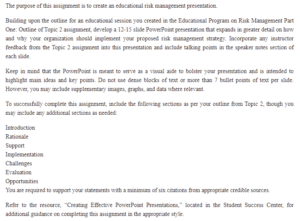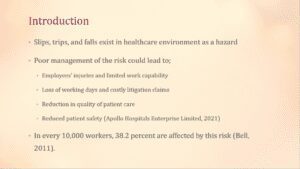Educational Program on Risk Management
Do you need any help for completing your assignment ? Contact us at eminencepapers.com. We endeavor to provide you with excellent service.
Slips, trips, and falls are common hazards in the healthcare environment. They pose risks to health workers and patients. In 2009, the U.S. Bureau of Labor Statistics established that the incidence rate for lost working days due to falls, trips, and slips was 38.2 percent for every 10,000 healthcare workers. Compared to other private sector players, this incidence rate was at least 90 percent higher than the average (Bell, 2011). This statistic confirms the certainty of the risk in the healthcare sector. Failure to manage the threat could lead to injuries among employees and patients, loss of working days, litigation costs due to compensation of claims, limited capability to work due to injuries, reduction in quality of care, and compromised patient safety. Slips, trips, and falls, are ranked as second after overexertion as it pertains to the loss of working days. In 2010, at least 9060 working days were lost because of this risk (Bell et al., 2013).
The leading factor responsible for the high occurrence of slips, trips, and falls is liquid contamination. The presence of water, grease, gel, wax, soapy solutions, and body fluids on the floor causes most slips, trips, and falls. This explains why most fall, and mistakes occur at decontamination spots, drinking fountains, soap dispensing spots, and food service areas. Obstruction of pathways by objects such as bedspreads, waste paper baskets, desk drawers that are open, boxes, wires, electric/phone cords, and wheelchairs also cause accidents. At the entrances of facilities, ice, snow, and water, due to rain, could cause slips, trips, and falls. Irregularities in indoor surfaces such as carpeting, rugs, and mats can also increase the risk of the hazard’s occurrence (Bell et al., 2013). Finally, elevation within and around the facility exposes employees to the danger. The most common injuries include tears, sprains, dislocations, and bruises. The most affected body parts are feet, body joints, ankles, and knees.
The rate of incidence for this risk is rated at 90 percent higher than the rest. It is ranked second among all other hazards that could lead to a loss of working days. The first one is overexertion. In 2010 alone, 9060 working days were lost due to slips, trips, and falls. The Organization of Safety and Health Administration (OSHA) requires all employers to provide safe working environments (Bell et al., 2013). Apollo Hospital Enterprises Limited is a health facility that acknowledges the risk of falls, trips, and slips for patients and healthcare workers (Apollo Hospitals Enterprise Limited, 2021). This hazard is inevitable due to the common areas where such accidents may occur and the vulnerable patients in the facility. The risk’s potential to cause serious injuries to workers and reduce their ability to work cannot be ignored. In addition, these injuries could lead to loss of financial resources through payment of claims. Furthermore, patients’ safety, as well as workers’ safety, is highly compromised if the risk remains unmanaged. In addition, the quality of patient care is likely to reduce significantly when working with injured healthcare workers (Bell, 2011).
Patients and healthcare workers sustain minor and serious injuries due to falls, slips, and trips. These injuries make it impossible to report to work or render services effectively. However, facilities such as Apollo Hospitals Enterprises Limited face lawsuits such as medical malpractice and premises liability claims. Such claims burden hospitals to dispute the evidence that a plaintiff provides to prove their negligence (Justia, 2021). The process is not only time-consuming but also costly.
To address the risk effectively, Apollo Hospitals Enterprises Limited requires its risk managers to conduct a safety analysis of the environment. The data regarding the number of falls the facility experiences in a given period should be recorded accurately. Monitoring this risk is important to establish the most vulnerable groups of workers and high-risk areas. It is also necessary to create an accurate record of the injuries that workers and patients sustain after the falls, trips, and slips. In the event of a fall, it is critical to provide detailed records that highlight the environment within which it occurred, drug dosage in case of patients, health conditions of the victim, shoe wear, areas within which the accident occurred, and the presence of any substance or other factors within the environment that led to the accident.
In the process of managing the risk, it is important to create records of the costs that the facility incurs due to falls, trips, and slips. These are likely to occur in litigation costs, payment of claims, quantifying the time spent in courts, and fees paid to attorneys. Additional charges include the management of negative public relations that could arise from such issues. Most importantly, creating awareness is critical in ensuring employees learn about the risk. The training process should effectively reduce the occurrence. Patients should be trained to improve safety at the workplace, properly manage high-risk areas, and cater to vulnerable patients. These steps are expected to reduce the rate of falls, slips, and trips at the facility significantly.
The main challenges expected during the implementation process include resistance from employees and patients. Employees are likely to demonstrate opposition subtly by failing to record data required for analysis and being inconsistent with the same. Alternatively, failure to train employees on record keeping and the need for risk mitigation can lead to a lack of care. Stubborn patients may also wrestle with the need for assistance from healthcare workers who already understand their vulnerability. The lack of accurate records will likely affect the data analysis process and make it impossible to obtain helpful conclusions that the facility can act upon. The physical environments and structures that increase the risk’s likelihood of occurrence will likely present significant challenges. The need to renovate high-risk areas or modify each is time and resource-consuming.
To tackle the risk, training is important. The employees need to understand its incidence rate, the harm it poses, the process of keeping records, the need to keep these records, and the impact on patient safety—the effect on the work environment safety and the types of injuries sustained by other victims. The provision of practical solutions is important. For instance, encourage employees to keep floors dry, place signposts for warning in wet areas, provide proper maintenance to ensure efficient drainage, provide waterproof gear, eliminate obstructions, and keep exits clear. Additional work practices that OSHA recommends include reporting/immediate cleaning of spillages, use of ladders that are well maintained, use of wax that is non-skid for creation of non-slip floor surfaces in high-risk areas, relay carpets to eliminate bulge, evening out floor surfaces, encourage workers to use handrails, avoid unnecessary speed, tape electric cords to floors and walls, and provide adequate lighting(OSHA, 2021). It is also necessary to collect feedback from employees on the various solutions already in place and keep them informed about the goals of the entire process. Creating work procedures that promote safety in the work environment is important.
To evaluate the process, data will be collected before, during, and after the implementation has begun. The method of data collection is dependent on record keeping. Accurate record entries by employees and risk managers promote the validity and reliability of the process. This data will be retained for analysis at the end of the program. Analysis of the recorded data will reveal the changes in accident rates, the effectiveness of various prevention strategies, and the need to review the entire process. The risk manager should apply the most appropriate analysis methods to ensure the conclusions are valid and reliable in creating work procedures that avert the risk occurrence.
As recommended by OSHA, it is necessary to put in place practical solutions that employees can utilize to reduce the occurrence of the risk. The collective responsibility towards this risk demands the involvement of all employees at various levels. Besides conducting training, employees should be aware of the importance of offering proactive assistance to patients. The facility should ensure that hazardous floors are changed or modified using carpets, mats, rugs, or anti-skid wax. Alarms for patients should be easily accessible. It is also necessary to inform high-risk patients to avoid falls, especially due to strong medication. Walking/support aids such as wheelchairs should be availed to patients. Obstacles should be cleared out of pathways. All employees should have access to appropriate shoe wear.
References
Apollo Hospitals Enterprise Limited. (2021). Reducing the Risk of Falls in the Hospital – Apollo Hospitals Leads the Way.
Bell, J. (2011). Slip, Trip, and Fall Prevention for Healthcare Workers. Retrieved from https://www.cdc.gov/niosh/docs/2011-123/pdfs/2011-123.pdf
Bell, J. L. (2013). Slip, Trip, and Fall Injuries Among Nursing Care Facility Workers. Workplace Health Saf., 61(4), 147-152. doi:10.3928/21650799-20130318-28
Drebit, S. (2010). Occupational and environmental risk factors for falls among workers in the healthcare sector. Ergonomics, 53(4), 525–536.
Justia. (2021). Slip and Fall Accidents.
OSHA. (2021). Healthcare Wide Hazards. Retrieved from United States Department of Labor: https://www.osha.gov/SLTC/etools/hospital/hazards/slips/slips.html
ORDER A PLAGIARISM-FREE PAPER HERE
We’ll write everything from scratch
Question
The purpose of this assignment is to create an educational risk management presentation.

Educational Program on Risk Management
Building upon the outline for an educational session you created in the Educational Program on Risk Management Part One: Outline of Topic 2 assignment, develop a 12-15 slide PowerPoint presentation that expands in greater detail on how and why your organization should implement your proposed risk management strategy. Incorporate any instructor feedback from the Topic 2 assignment into this presentation and include talking points in the speaker notes section of each slide.
Remember that PowerPoint is meant to serve as a visual aid to bolster your presentation and is intended to highlight the main ideas and key points. Do not use dense blocks of text or more than seven bullet points per slide. However, you may include supplementary images, graphs, and data where relevant.
To complete this assignment, include the following sections as per your outline from Topic 2, though you may consist of any additional areas as needed:
Introduction
Rationale
Support
Implementation
Challenges
Evaluation
Opportunities
You must support your statements with at least six citations from appropriate, credible sources.
Refer to the resource “Creating Effective PowerPoint Presentations,” located in the Student Success Center, for additional guidance on completing this assignment in the appropriate style.














